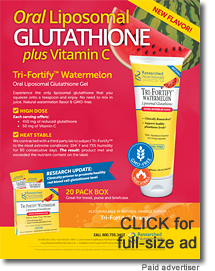Page 1, 2
Top Anti-Inflammatory Foods
Although inflammation is often necessary as a protective defense against infection and injury, unchecked, chronic inflammation is implicated in a number of diseases. The lifelong accumulation of molecular damage that results from chronic inflammation has been suggested to serve as a major contributor to the aging process. When the immune system begins overacting and starts attacking healthy body tissue, inflammation can lead to a whole litany of issues – most notably, arthritis, autoimmune diseases, and certain cancers.
Considering these facts, it only makes sense that preventing and/or eliminating inflammation is one of the best ways to maintain a healthy life. Nature has provided a variety of foods and nutrients that have anti-inflammatory properties, and it only makes good sense to protect your health, by including some of these in your diet. You will be happy to know that most of these foods are flavorful and pleasant to eat.
Chocolate: You can enjoy this rich and delicious treat without a lot of guilt, but only dark chocolate with 70 percent or more concentration of cacao. Milk chocolate is not healthy, due to the high concentration of sugar and fat.
Berries: These delicious fruits, especially blueberries, strawberries, blackberries and raspberries, are packed with flavor as well as fiber, vitamins, minerals, and antioxidants.
Fatty fish: Not everyone loves fish, but many people enjoy a Friday night fish fry. Salmon is high in Omega-3 oils, but rather costly so taking a daily fish oil supplement is advisable.
Cruciferous vegetables, including broccoli, cauliflower, kale and brussels sprouts, are high in beneficial antioxidants. These veggies are easy to include in your nutritious diet and are readily available at a reasonable price.
Avocados: This versatile fruit is packed with healthy fat, fiber, and antioxidants. It tastes great in salads, sandwiches and is the main ingredient in guacamole, the flavorful Mexican dip served with chips and veggies.
Green tea: If you are like millions of people around the world, you begin your day with a cup of coffee. Coffee does contain some antioxidants, but green tea is a better choice. Green tea will provide the caffeine you need to quick-start your day, but its much higher antioxidant level also helps to protect against cancer, heart disease, and Alzheimer's disease.
Mushrooms, olive oil and tomatoes: These three foods are included as ingredients in many healthy recipes – either separately or together. Many Italian dishes include these ingredients, and the combination provides a powerful cocktail of anti-inflammatory compounds. Lycopene is a compound in tomatoes that has been found to reduce inflammation and protect against various types of cancer. In addition, cooking tomatoes in olive oil increases the amount of lycopene that you can absorb by eating the combination.
Mushrooms are an ingredient found in many dishes, and they also contain anti-inflammatory compounds. Since cooking can reduce the anti-inflammatory benefits, most nutritionists recommend eating mushrooms raw or only slightly cooked.
Turmeric: While turmeric is not technically a food, this spice has been used to flavor Indian dishes for hundreds of years. Curcumin is a powerful anti-inflammatory nutrient contained in turmeric that effectively reduces the pain of arthritis and is also thought to help prevent cancer and Alzheimer's disease. The effects of turmeric can be greatly increased if you eat black pepper with it. Black pepper contains piperine, a nutrient that aids in the absorption of curcumin.
 Inflammation is the natural immune response of your body to anything it recognizes as a threat, and the reaction is meant to protect your health. Without a certain amount of inflammation, your health would be at risk from invading microbes, viruses, and bacteria. Some foods such as red meat and refined carbohydrates can cause inflammation in your body, so eliminating or reducing them in your diet can keep you healthier. Inflammation is the natural immune response of your body to anything it recognizes as a threat, and the reaction is meant to protect your health. Without a certain amount of inflammation, your health would be at risk from invading microbes, viruses, and bacteria. Some foods such as red meat and refined carbohydrates can cause inflammation in your body, so eliminating or reducing them in your diet can keep you healthier.
Fortunately, the healthy foods that fight inflammation are appetizing and easily available. Your best chance to live a long and active life is to avoid unhealthy foods that cause weight gain and inflammation, and educate yourself about which foods provide proper nutrition and antioxidants to help fight disease.
http://www.health.harvard.edu/staying-healthy/foods-that-fight-inflammation
http://umm.edu/health/medical/altmed/herb/turmeric
https://authoritynutrition.com/13-anti-inflammatory-foods/
http://www.drweil.com/diet-nutrition/anti-inflammatory-diet-pyramid/
Anti-Aging Benefits of Walnuts
Previous studies have shown that walnuts may slow cancer and improve memory, concentration, and information processing speed, as well as lowering diabetes risk and boosting male fertility. Now, more recently, initial findings from the Walnuts and Healthy Aging (WAHA) study, presented at Experimental Biology 2016 (EB), are showing that daily walnut consumption positively impacts blood cholesterol levels without adverse effects on body weight among older adults. The WAHA study is a dual-site two-year clinical trial, conducted by researchers from the Hospital Clinic of Barcelona and Loma Linda University, and is focused on determining the effect that walnuts have on health issues that are age-related.
The 707 older adults who participated in the study consumed either a daily dose of walnuts (compiling less than 15% of daily caloric intake), or a diet absent of all nuts. There was no guidance given, as to suggested total calorie and macronutrient intake, or food substitutions for walnuts. After one year, there was no evident effect on body weight, triglycerides, and HDL cholesterol, for either group. However, those whose diets consisted of the walnuts resulted in significant reductions in LDL cholesterol in comparison with the nut-free diet.
Additional new research abstracts presented at the EB meeting included information regarding walnuts and the following:
Gut health – A recent study conducted by researchers at the Agricultural Research Service, United States Department of Agriculture (USDA) found that eating 1.5 ounces of walnuts daily significantly affects the bacteria in the human gut in a manner that is favorable to decreasing inflammation and cholesterol, which are two known indicators of heart health.
Hunger and Satiety – For the first time, it has been shown that the types of fat consumed on a daily basis can change long-term appetite responses, such as hunger and satiety. Researchers from the University of Georgia found that eating a diet high in polyunsaturated fat, after meals rich in saturated fat, favorably alters hunger and satiety markers. At 13 grams per ounce, walnuts are a great choice for getting more polyunsaturated fat.
Metabolic Health – A recent study conducted at Oregon State University found that a diet consisting of walnuts supplemented with polyphenol-rich foods such as raspberries, cherries or green tea may help reduce inflammation. This study was conducted on mice who were given walnuts on their own or along with polyphenol-rich foods. However, as it was performed on animals, the results cannot yet be considered applicable to humans.
Definitive scientific conclusions cannot yet be drawn from the abstracts presented at EB 2016, however these findings help advance the knowledge of possible benefits of consuming walnuts as part of a healthy diet.
1. Ros E, Rajaram S, Sala-Vila A, et al. Effect of a 1-Year Walnut Supplementation on Blood Lipids among Older Individuals: Findings from the Walnuts and Healthy Aging (WAHA) study [abstract]. FASEB J. 2016;30(Supp 1)293.4.
2. Guetterman HM, Swanson KS, Novotny JA, et al. Walnut Consumption Influences the Human Gut Microbiome [abstract]. FASEB J. 2016;30(Supp 1)406.2.
3. Cooper JA, Stevenson JL, Paton CM. Hunger and satiety responses to saturated fat-rich meals before and after a high PUFA diet [abstract]. FASEB J. 2016;30(Supp 1)405.7.
4. Shay NF, Luo T, Miranda O, et al. Mice Fed High-fat Obesigenic Diets with Walnut Plus Other Whole Foods Demonstrate Metabolic Improvement and Changes in Gene Expression and Metabolomic Patterns [abstract]. FASEB J. 2016;30(Supp 1)428.3.
Honey Compounds as Antibiotic Alternative
Natural products such as honey have been applied against human infections and are a staple of folk medicine. Today, interest in honey as an alternative to antibiotics is peaking in both developing countries – where fresh honey is easily available, as well as Western countries – where antibiotic resistance is seriously increasing. Tobias C. Olofsson, from Lund University (Sweden), and colleagues have identified a unique group of 13 lactic acid bacteria found in fresh honey, from the honey stomach of bees. The bacteria produce a myriad of active antimicrobial compounds. These lactic acid bacteria have now been tested on severe human wound pathogens such as methicillin-resistant Staphylococcus aureus (MRSA), Pseudomonas aeruginosa and vancomycin-resistant Enterococcus (VRE), among others. When the lactic acid bacteria were applied to the pathogens in the laboratory, it counteracted all of them. While the effect on human bacteria has only been tested in a lab environment thus far, the lactic acid bacteria has been applied directly to horses with persistent wounds. The lactic acid bacteria was mixed with honey and applied to ten horses whose owners had tried several other methods to no avail. All of the horses' wounds were healed by the mixture. "We demonstrate a strong antimicrobial activity from each symbiont and a synergistic effect, which counteracted all the tested pathogens," the study authors write and submit: "The mechanisms of action are partly shown by elucidating the production of active compounds such as proteins, fatty acids, anaesthetics, organic acids, volatiles and hydrogen peroxide. We show that the symbionts produce a myriad of active compounds that remain in variable amounts in mature honey."
Olofsson TC, Butler E, Markowicz P, et al. Lactic acid bacterial symbionts in honeybees – an unknown key to honey's antimicrobial and therapeutic activities. Intl Wound J. 8 Sept. 2014.
To stay updated on the latest breakthroughs in natural approaches, visit the World Health Network (www.worldhealth.net), the official educational website of the A4M and your one-stop resource for authoritative anti-aging information. Be sure to sign up for the free Longevity Magazine e-journal, your weekly health newsletter featuring wellness, prevention, and biotech advancements in longevity.
Page 1, 2 |
![]()
![]()
![]()
![]()






